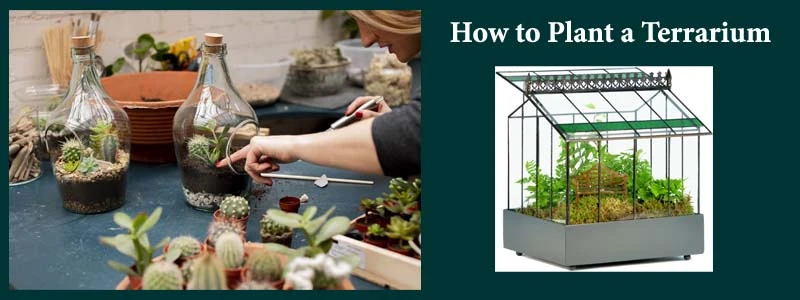reviewed by Christina Lopez
Gardens do not have to be outdoors at all times. You can create your little ‘heaven’ inside your home if you have space issues. They add a powerful sense of beautiful nature. Also, they make you responsible for the plant’s growth. Getting terrariums is precious. These are DIY gardens that you can include in your room. It is a simple and creative project worthwhile your time. Then do you know how to plant a terrarium?
The article aims to take the fundamental knowledge, the steps and tips to consider, and the common mistakes to avoid when planting your terrarium.
Contents
A terrarium is a miniature garden that initially began as sealed glass containers. Today, you have the option to either seal to conserve water or open to allow airflow.
Things you need to plant a terrarium
Planting a terrarium will not take much of your time. You can spare at least an hour for this enjoyable activity.
Before planting a terrarium, you need to have the following tools:

Below is a step-to-step guideline on how to plant a terrarium. Then, take a closer look for assured marvelous results.
A container for your terrarium can be anything from a used vessel. Or, you might purchase already made containers that vary in size and shape. You can even go for a reused clean pickle jar container.
All in all, ensure you have a clear container. Do not pick colored containers for this activity. They might hinder your plant’s growth. Also, pay attention to the size of the lid or mouth opening. Some containers might have smaller spaces that might raise issues when dipping your plants or materials.
It would be wise to select smaller plants that can fit your glass jar. Echeveria plants are perfect for your terrarium. Some other plants grow perfectly between the rocky material.
You need to place the plant in a more relaxed and brighter section of your room that does not permit direct sunlight. For example, your terrarium might be perfect when you use the following plants:
These containers do not come with drainage holes. Therefore, you will need to establish a drainage layer to provide adequate moisture for the chosen plants.
At this step, you can place a moss layer at the bottom of the container to soak the excess water. You can preferably put a tiny layer of stones, at least 2 inches, before placing the moss layer.
Next, use a large spoon to dip a quarter layer of activated charcoal. It will assist with the drainage and will manage all odors.
Now, include a moss layer over the charcoal and the beach stones. It assists in preventing the soil from mixing with charcoal and pebbles. It will also add some visual appealing to the terrarium.
Using a large spoon, add a potting mix over the moss. The soil of choice should be compatible with the terrarium plant. You can adjust the mixed content and include a suitable amount. Ensure the soil level is not extreme. The plants need not touch the mouth or lid of the container.
You can now remove your plants from the pots. In case they have roots, loosen or cut them. The roots might affect the plant’s growth.
Get rid of excess soil present in the plants. Then, you can use a more oversized spoon or your fingers to prepare holes for the potting mix plants.
Place the plants into the prepared holes. Then, add soil around them and finalize with patting the soil.
Decorating your terrarium is entirely optional. However, if you are interested in this step, you might use shells or other different accents for your plants.
You can spread water on your terrarium using a spray bottle or a watering can. The step goal is to make your plants damp and not wet.
You might also leverage the spray bottle to clean any dirt left on the glass surface. Finally, you can use a newspaper to dry the wet container. It is crucial to stay away from glass cleaners. They might contain toxic substances that may be poisonous to your plants.
Maintaining a terrarium is quite simple. However, you might need to comply with the following steps:
Besides the container types, you might comply with the tips below when making a terrarium.
When getting a terrarium plant, you might choose plants that nurture well in medium to lower-light environments. You can combine a mixture of leaf textures and colors and different sizes. The plants should also perform well in the humid vicinity of the terrarium.
Larger terrariums can accommodate bigger plants. However, it would help if you avoided fast-growing species that might block light for the smaller plants.
When you decide to settle with an enclosed terrarium, you need to avoid plant species such as cactus. These plants are suitable for open containers that consist of mixes with a variety of coarse sands.
How to Style Your Terrarium
Terrariums do not limit you to choosing a particular vessel. You can settle with either a hanging container or a closed rectangular box with a lid.
You can purchase different vessel shapes from the nearest physical store or online.
Terrariums require lower maintenance and attention, unlike other house plants. However, there are various mistakes that most individuals commit when handling terrariums.
Some of the common terrarium mistakes include the following:
Terrarium plants are not suitable for excess sunlight. Too much light can serve the glass container as a magnifier and burn up the plants. In addition, it might raise the inside temperature and create excess steam inside the container. Most of these plants cannot withstand this type of heat.
Alongside the excess light, you also need not put your terrarium plants in a darker room. They might not survive. If you are struggling with indirect light, you can opt for supplemental light sources for your plants.
Or, you can place your terrarium plant closer to a window. It will allow suitable and indirect light good for your terrarium plants.
If your plant is closer to a radiator, it might die quickly. Therefore, it would be helpful to distant your terrarium plant from heat sources available in your home.
When you forget to give your plants some attention, they might over-grow while in the terrarium. You might consider keeping your miniature garden tidier by trimming the over-grown plants.
If it is necessary, you can prune the roots. Where is the fun of having a terrarium flocked with roots, and you cannot see the decorative elements?
You can avoid over-watering your terrarium plants by using a spray bottle rather than a watering can. In case of any excess water, you can use a paper towel for the draining. You can let the container open until all the water has dried out.
If your terrarium has dying plants, you can get rid of them immediately. It will not affect other plants present in the terrarium. You might remove the dying plants with a spoon or shovel. Be careful not to interfere with the roots of other plants.
You can replace the dead plants with other ones that match similar light and moisture requirements. Pat the soil well after planting to prevent potential air pockets.
Occasionally, clean the interior and the exterior parts of the glass container. It might be difficult for the light to perform its magic on a dirty surface. You can use a damp, lint-free cloth for cleaning.
It is crucial to select suitable types of plants for your terrarium. Plants in a closed terrarium work perfectly in a moist environment. It is advisable to choose terrarium plants that require less light.
Planting a terrarium for your home or business is quite simple. However, it would be best if you get the right tools and guidelines for excellent outcomes. The article has come in handy to provide you with a step-by-step approach to this activity.
It has also backed you up with common mistakes to avoid alongside practical tips on the making and style of a terrarium plant. With all this information, you can now comfortably plant a terrarium.
 |
 |
 |
 |

About Christina Lopez
Christina Lopez grew up in the scenic city of Mountain View, California. For eighteen ascetic years, she refrained from eating meat until she discovered the exquisite delicacy of chicken thighs. Christina is a city finalist competitive pingpong player, an ocean diver, and an ex-pat in England and Japan. Currently, she is a computer science doctoral student. Christina writes late at night; most of her daytime is spent enchanting her magical herb garden.
 |
 |
 |
 |
Get new FREE Gifts. Or latest free growing e-books from our latest works.
Disable Ad block to reveal all the links. Once done, hit a button below
 |
 |
 |
 |